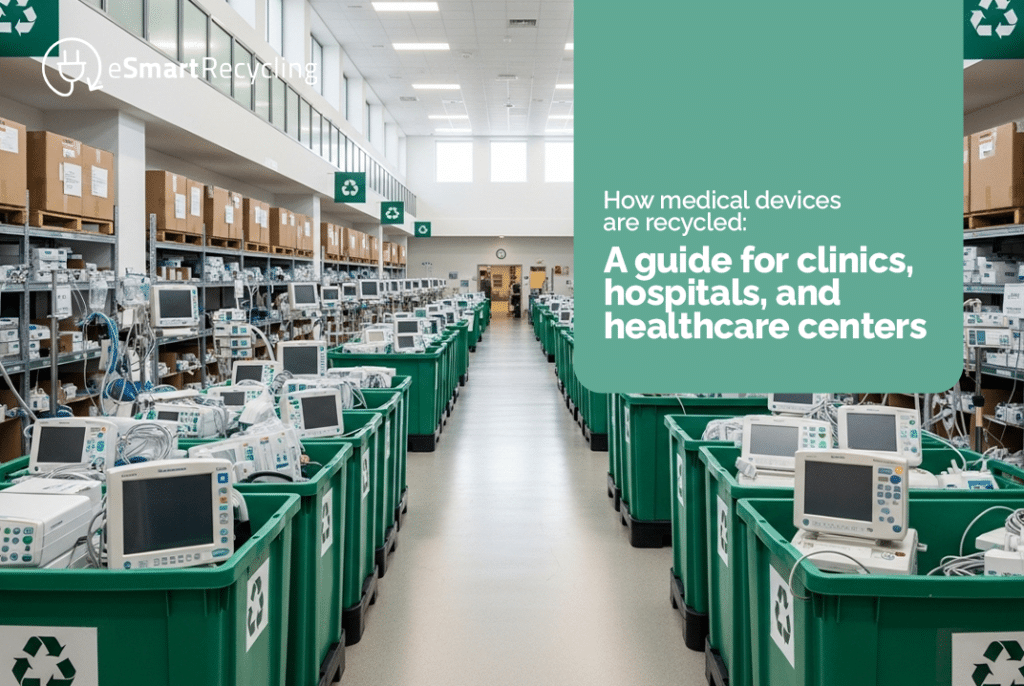
Recycling medical devices is no longer something hospitals and clinics in the U.S. can afford to overlook. These are not just old machines collecting dust—once they reach the end of their life, they can either become an environmental and compliance headache… or an opportunity to drive sustainability forward.
Simply put, recycling medical equipment involves collecting outdated devices, erasing any patient information they may hold, dismantling them, and separating their materials. Metals, plastics, and even batteries can be put back into the supply chain. The key is doing it within regulations: the EPA oversees medical and pharmaceutical waste management, while HIPAA requires strict protection of patient data.
It all starts with classification: monitors, infusion pumps, plastic components, batteries—each category follows a different stream. Next is data elimination, which is crucial for compliance. It’s not just about unplugging the device—secure data wiping software or physical destruction of memory storage is required.
Once the data is cleared, the devices are dismantled. Recyclable materials are separated and sent to specialized processors, while hazardous parts are handled with extra care. The best practice is to partner with certified recyclers, such as R2 or e-Stewards, which guarantee safe and environmentally responsible processes (SAMR Inc.).
Finally, hospitals receive a certificate of recycling, an important document proving that waste was handled properly—often essential for sustainability reporting.
In some cases, recycling isn’t the only option. There’s also reprocessing of single-use devices. This means cleaning, sterilizing, and reusing them under FDA-approved safety standards. Far from being niche, this practice can save hospitals millions of dollars while preventing tons of medical waste from ending up in landfills (Wikipedia: Single-use medical device reprocessing).
In 2025, “going green” is no longer a slogan. Recycling and reprocessing medical devices is now a strategy for saving money, staying compliant, and leading in sustainability. And those who start today will be a step ahead tomorrow.
Fill out the form below to request your electronics recycling pickup.
We’ll coordinate the schedule logistics and follow up with next steps.
Modular electronics are changing how we see technology. It’s no longer just about buying new — it’s about replacing only what’s broken. This design approach favors repairability and extends product lifespans, making it increasingly relevant for sustainability leaders and tech managers across companies.
A modular device is built from separate units —modules— each handling a specific function (like battery, camera, or connectivity). If one fails, it can be swapped out instead of discarding the entire product. This differs from traditional monolithic designs, where parts are glued, sealed, or inaccessible.
So why is modular design gaining ground in 2025? Three forces are driving this shift:
Instead of buying entirely new equipment, companies only replace the failed module. Dell, for example, uses modular strategies in its PCs to cut waste and reduce after-sales costs.
Keeping stock of standardized modules means repairs can be handled internally or by local partners without full manufacturer dependency.
Hardware or performance upgrades can be achieved through selective module updates — no need to discard the whole system.
Brands that support modular repairability send a clear message of responsibility to customers, investors, and regulators.
To overcome these:
At eSmart Recycling, we see modular electronics as a powerful ally to our mission: extending the useful life of technology before recycling. By providing infrastructure for recovery and reuse, we help companies and communities take part in a more responsible digital cycle.
Behind every scroll and search lies an invisible energy engine. In 2025, data centers and transmission networks account for about 1 % of global energy-related greenhouse gas emissions.
In the U.S. alone, over 2,100 data centers consume more than 4 % of the country’s total electricity, producing over 105 million tons of CO₂ equivalent annually.
AI systems amplify this footprint. Training large-scale models requires huge hardware clusters and vast amounts of electricity, while building those facilities already embeds a heavy carbon cost.
Cooling alone can represent nearly 40 % of a data center’s total power use.
Our phones, laptops, and wearables also come with a hidden cost. According to Ericsson, a typical smartphone generates around 62 kg of CO₂ equivalent per year when accounting for networks and data centers.
Studies show that 70–80 % of a phone’s lifetime emissions come from manufacturing—mainly metal extraction, assembly, and transportation. Deloitte estimates that a new smartphone emits around 85 kg of CO₂ in its first year, with about 83 % tied to production and logistics.
Extending device lifespans makes a real difference: reusing a phone or laptop just one extra year can significantly reduce total emissions.
But many devices still end up as e-waste. In 2022, the world produced 62 million metric tons of electronic waste—about 7.8 kg per person—and only 22 % was properly recycled.
These discarded electronics contain toxic materials like mercury, lead, and cadmium that can pollute soil and water. Between 2014 and 2020, emissions linked to e-waste grew 53 %, according to the University of California, Irvine.
The small things we do online—streaming, sending, storing—accumulate fast. For example:
Our constant connectivity keeps this system running 24 hours a day.
At eSmart Recycling, we work to make the digital world more sustainable. Here are a few actions that organizations in the U.S. can take:
Our connected lives don’t have to harm the planet—but awareness is the first step. Recognizing this hidden cost helps companies and individuals make smarter choices that protect both people and the environment.
The clearest trend for 2026 is that tech recycling will no longer be a secondary environmental task — it’s becoming a strategic priority for companies that want to meet regulations, protect their reputation, and make better use of limited resources. Recycling will be more transparent, automated, and connected at every stage.
By 2026, many recycling facilities will rely on robotics, computer vision, and AI to separate electronic components with greater accuracy. Companies are already deploying automated systems that recognize circuit boards, plastics, and precious metals.
Recent research suggests combining IoT sensors with machine learning models so that smart bins can identify devices and sort them instantly.
The outcome: fewer hazardous leftovers, safer conditions for workers, and smoother, faster operations.
Many devices contain metals that are rarely recycled, like rare earth elements or platinum. In 2025, researchers at ETH Zurich developed a method to extract elements such as europium with higher chemical selectivity.
Other techniques, such as bioleaching (using bacteria), hydrometallurgy, and cleaner chemical processes, are also gaining ground.
These innovations will help capture more materials while reducing dependence on mining and resource extraction.
To keep recycling from being the last step in the process, companies are rethinking how devices are made — designing products that are easy to disassemble and reuse.
More brands are launching take-back and refurbishment programs to keep devices and components in circulation.
The global e-waste recycling market is expected to reach USD 48.9 billion by 2026, driven by new regulations and stronger producer responsibility policies.
Companies are demanding greater visibility over what happens to their discarded devices: what percentage gets recycled, refurbished, or safely destroyed.
Technologies like blockchain can help create verifiable records that trace each item’s full journey.
In the U.S. and Europe, Extended Producer Responsibility (EPR) laws are becoming more common. Businesses will increasingly be held accountable for the entire lifecycle of their products.
Global e-waste keeps climbing — over 62 million tons were generated in 2022, but only 22.3 % was formally recycled.
If infrastructure and accountability don’t improve, that rate could drop to around 20 % by 2030.
For companies, working with certified recyclers isn’t just environmental responsibility — it’s a way to reduce legal and reputational risk.
Tech recycling is evolving fast, but its mission remains simple: take care of resources, and take care of people.
At eSmart Recycling, we believe every device restored tells a small story — one where technology finds new meaning and helps close the digital gap.
When you hand in your old devices — laptops, printers, routers, cables — they don’t just vanish into thin air. They begin a process that helps protect the planet and sometimes gives technology a second life. Here’s what really happens next, why doing it right matters, and how we at eSmart Recycling make sure every piece you recycle truly counts.
Once your devices are collected or dropped off:
Functional components — memory, drives, or circuit boards — are repaired or certified to be reintegrated into refurbished devices. At eSmart Recycling, around 30% of our revenue goes toward repairing and delivering functional equipment to communities that need it.
Non-reusable components go through technical recycling stages that include:
This reduces both waste volume and environmental risks.
If electronics aren’t recycled properly:
That’s why certified recyclers with transparent processes are essential.
If you manage sustainability in a company, here’s what you should look for:
At eSmart Recycling, we follow these principles: we collect equipment, audit every step, destroy data securely, reuse what’s viable, and recycle what’s not. We also issue social and environmental reports for our partners.
How much of what I recycle actually gets recovered?
It depends on the type of equipment, but most of the mass — metals and plastics — can be recycled. The small remainder is inert waste.
Are my devices exported?
Not with us. We ensure all processing happens under legal, audited, and responsible conditions.
How long does the process take?
From collection to certification, it can take anywhere from a few days to several weeks, depending on the volume and type of devices.
When you choose to recycle your electronics with us, you’re not just getting rid of old gear — you’re helping extend the life of valuable materials, protecting sensitive data, and bringing access to technology where it’s needed most. That’s what real, responsible recycling looks like.
If a school wants to teach electronic recycling practically, the most effective approach is to turn old computers into living learning tools. It’s not enough to talk about sustainability — reusing, repairing, and recycling the school’s own devices engages students, teachers, and the whole community. Here’s how to do it step by step, with real examples and solid sources.
Many schools have obsolete devices sitting unused or sent straight to the landfill.
Programs like Computers for Learning, managed by the U.S. General Services Administration, allow federal agencies to transfer used computers to schools and educational organizations.
Extending a device’s lifespan prevents it from becoming e-waste and reduces environmental damage from heavy metals and toxic components.
In return, schools gain valuable benefits: more space, a tangible sense of responsibility, and real-world learning experiences that combine science, technology, and sustainability.
Start by identifying what you already have: functional, repairable, damaged, or beyond repair. Classify devices based on whether they can be fixed, reused, or must be recycled by a certified partner. This internal audit sets the foundation for a hands-on educational program.
To make recycling part of everyday learning rather than an extracurricular activity, tie it to subjects like science, technology, or environmental studies:
Field trips or partnerships with local recyclers can also deepen learning.
When devices can no longer be reused, work with responsible recyclers:
By teaching electronic recycling through old computers, schools move from awareness to action. Students experience the full life cycle of technology, from use to responsible reuse. At eSmart Recycling, we’re proud to help schools and partners build programs that make sustainability part of everyday learning — one device at a time.
Eco-friendly design —also known as ecodesign— has become essential in technology manufacturing. If it’s not considered early in a product’s lifecycle, companies face higher regulatory costs, wasted materials, reputational pressure, and the risk of falling behind clients who already value sustainability.
Eco-friendly design looks at every part of a device —materials, assembly, repairability, disassembly, recycling— to minimize its environmental footprint. It’s not just about making something “green.” It’s about ensuring the product is built to:
A study shows that up to 80% of a product’s environmental footprint is determined during its design phase, since it influences everything from extraction to disposal.
When design doesn’t account for recyclability or reuse, the diversity of components and materials (“component diversity”) makes recovery extremely difficult.
Applying eco-friendly design helps both the planet and business operations:
The green electronics manufacturing market is projected to grow from about USD 12.9 billion in 2024 to USD 24.2 billion by 2032. Another report estimates it will reach USD 15.33 billion in 2025 with a 23.8% annual growth rate.
These projections show that companies integrating eco-friendly design early on will have a stronger position in the years ahead.
The shift comes with hurdles. Some of the main ones include:
Here are a few ways companies can implement eco-friendly design in practice:
At eSmart Recycling, we experience this every day. When we receive devices for secure destruction or refurbishment, we can tell how much easier it is to recover and reuse technology that was originally designed with sustainability in mind.
Eco-friendly design is becoming a standard requirement in technology manufacturing. Companies that embrace it early will be better prepared in regulatory, commercial, and operational terms. For sustainability leaders, this is the right moment to make design part of the product strategy — from the very beginning.
When a product is conceived with environmental awareness, its entire lifecycle —from use to recovery— flows more smoothly and leaves a better footprint for everyone.







If you want to know more about the different programs, partners, and overall cool things happening in the eSmart world, share your email with us, and Join the E-Revolution.